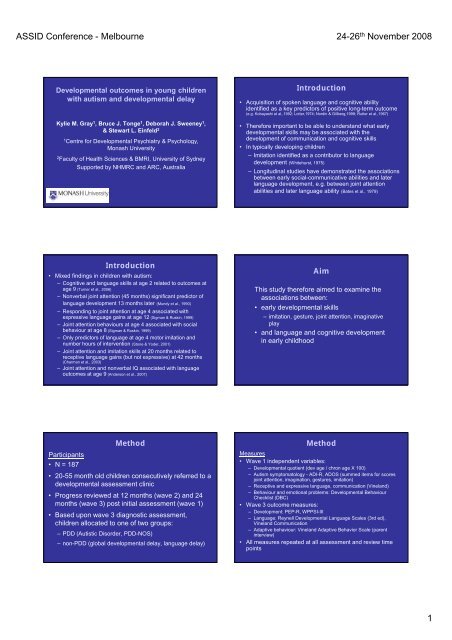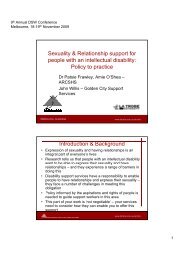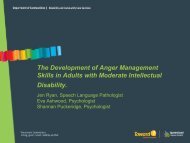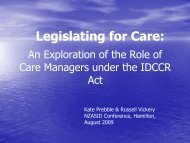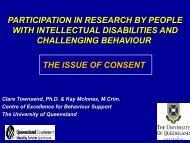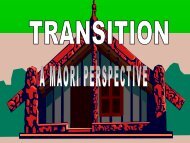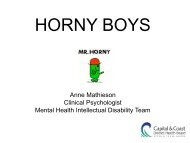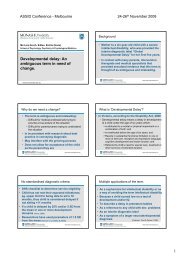Developmental outcomes in young children with Autism and ...
Developmental outcomes in young children with Autism and ...
Developmental outcomes in young children with Autism and ...
You also want an ePaper? Increase the reach of your titles
YUMPU automatically turns print PDFs into web optimized ePapers that Google loves.
ASSID Conference - Melbourne 24-26 th November 2008<strong>Developmental</strong> <strong>outcomes</strong> <strong>in</strong> <strong>young</strong> <strong>children</strong><strong>with</strong> autism <strong>and</strong> developmental delayKylie M. Gray 1 , Bruce J. Tonge 1 , Deborah J. Sweeney 1 ,& Stewart L. E<strong>in</strong>feld 21 Centre for <strong>Developmental</strong> Psychiatry & Psychology,Monash University2Faculty of Health Sciences & BMRI, University of SydneySupported by NHMRC <strong>and</strong> ARC, AustraliaIntroduction• Acquisition of spoken language <strong>and</strong> cognitive abilityidentified as a key predictors of positive long-term outcome(e.g. Kobayashi et al.,1992; Lotter,1974; Nord<strong>in</strong> & Gillberg,1998; Rutter et al.,1967)• Therefore important to be able to underst<strong>and</strong> what earlydevelopmental skills may be associated <strong>with</strong> thedevelopment of communication <strong>and</strong> cognitive skills• In typically develop<strong>in</strong>g <strong>children</strong>– Imitation identified as a contributor to languagedevelopment (Whitehurst, 1975)– Longitud<strong>in</strong>al studies have demonstrated the associationsbetween early social-communicative abilities <strong>and</strong> laterlanguage development, e.g. between jo<strong>in</strong>t attentionabilities <strong>and</strong> later language ability (Bates et al., 1979)Introduction• Mixed f<strong>in</strong>d<strong>in</strong>gs <strong>in</strong> <strong>children</strong> <strong>with</strong> autism:– Cognitive <strong>and</strong> language skills at age 2 related to <strong>outcomes</strong> atage 9 (Turner et al., 2006)– Nonverbal jo<strong>in</strong>t attention (45 months) significant predictor oflanguage development 13 months later (Mundy et al., 1990)– Respond<strong>in</strong>g to jo<strong>in</strong>t attention at age 4 associated <strong>with</strong>expressive language g ga<strong>in</strong>s at age 12 (Sigman & Rusk<strong>in</strong>, 1999)– Jo<strong>in</strong>t attention behaviours at age 4 associated <strong>with</strong> socialbehaviour at age 8 (Sigman & Rusk<strong>in</strong>, 1999)– Only predictors of language at age 4 motor imitation <strong>and</strong>number hours of <strong>in</strong>tervention (Stone & Yoder, 2001)– Jo<strong>in</strong>t attention <strong>and</strong> imitation skills at 20 months related toreceptive language ga<strong>in</strong>s (but not expressive) at 42 months(Charman et al., 2003)– Jo<strong>in</strong>t attention <strong>and</strong> nonverbal IQ associated <strong>with</strong> language<strong>outcomes</strong> at age 9 (Anderson et al., 2007)AimThis study therefore aimed to exam<strong>in</strong>e theassociations between:• early developmental skills– imitation, gesture, jo<strong>in</strong>t attention, imag<strong>in</strong>ativeplay• <strong>and</strong> language <strong>and</strong> cognitive development<strong>in</strong> early childhoodMethodParticipants• N = 187• 20-55 month old <strong>children</strong> consecutively referred to adevelopmental assessment cl<strong>in</strong>ic• Progress reviewed at 12 months (wave 2) <strong>and</strong> 24months (wave 3) post <strong>in</strong>itial assessment (wave 1)• Based upon wave 3 diagnostic assessment,<strong>children</strong> allocated to one of two groups:– PDD (Autistic Disorder, PDD-NOS)– non-PDD (global developmental delay, language delay)MethodMeasures• Wave 1 <strong>in</strong>dependent variables:– <strong>Developmental</strong> quotient (dev age / chron age X 100)– <strong>Autism</strong> symptomatology - ADI-R, ADOS (summed items for scoresjo<strong>in</strong>t attention, imag<strong>in</strong>ation, gestures, imitation)– Receptive <strong>and</strong> expressive language, communication (V<strong>in</strong>el<strong>and</strong>)– Behaviour <strong>and</strong> emotional problems: <strong>Developmental</strong> BehaviourChecklist (DBC)• Wave 3 outcome measures:– Development: PEP-R, WPPSI-III– Language: Reynell <strong>Developmental</strong> Language Scales (3rd ed),V<strong>in</strong>el<strong>and</strong> Communication– Adaptive behaviour: V<strong>in</strong>el<strong>and</strong> Adaptive Behavior Scale (parent<strong>in</strong>terview)• All measures repeated at all assessment <strong>and</strong> review timepo<strong>in</strong>ts1
ASSID Conference - Melbourne 24-26 th November 2008Sample characteristicsDiagnostic change over timePDDN=128Wave 1 Wave 3Non PDDN=59PDDN=113Non PDDN=55Gender (% male) 89% 71% 87% 41%Mean age (months) 39.3 (7.8) 37.9 (6.9) 62.1 (7.2) 63.3 (7.8)Age range 22-55 20-55 46-79 44-80Mean dev age 21.8 (9.0) 29.4 (8.5)** 25.3 (12.0) 25.5 (5.0)Dev age range 4-48 14-44 8-72 22-29Mean FSIQ 87.0 (4.2) 89.5 (12.8) 80.3 (17.6) 86.1 (14.6)*FSIQ range 84-90 73-103 45-129 52-12289.8% response rate at Wave 3 (19 families decl<strong>in</strong>ed to participate <strong>in</strong> follow-up)*Wave 1 PDDNOS=24, Wave 3 PDDNOS=4** p
ASSID Conference - Melbourne 24-26 th November 2008Results –correlations for PDD sample• Wave 1 imag<strong>in</strong>ative play significantly correlated <strong>with</strong>Wave 3 Communication (V<strong>in</strong>el<strong>and</strong>) <strong>and</strong> expressivelanguage• Wave 1 imitation significantly correlated <strong>with</strong> Wave 3Communication (V<strong>in</strong>el<strong>and</strong>)• Wave 1 use of gestures significantly correlated <strong>with</strong>Wave 3 Communication (V<strong>in</strong>el<strong>and</strong>), receptivelanguage, expressive language, VIQ, <strong>and</strong>developmental age (PEP-R)Regression analyses: Wave 3developmental <strong>outcomes</strong>• Wave 1 developmental quotient (dev age <strong>and</strong>chron age) consistently associated <strong>with</strong>language, g cognitive <strong>and</strong> adaptive outcome atwave 3 for all <strong>children</strong>Regression analyses: Wave 3 developmental<strong>outcomes</strong> non PDD sampleRegression analyses: Wave 3 developmental<strong>outcomes</strong> for PDD sampleNon PDD sampleWave 3 <strong>outcomes</strong>W1 variables significant associationsPDD sampleWave 3 <strong>outcomes</strong>W1 variables significant associationsWPPSI VIQWPPSI PIQExpressive languageReceptive languageV<strong>in</strong>el<strong>and</strong> CommunicationV<strong>in</strong>el<strong>and</strong> SocialisationV<strong>in</strong>el<strong>and</strong> Daily Liv<strong>in</strong>g SkillsAdaptive Behavior CompositeCommunication (V<strong>in</strong>el<strong>and</strong>), expressivelanguage<strong>Developmental</strong> quotient onlyCommunication (V<strong>in</strong>el<strong>and</strong>)<strong>Developmental</strong> quotient only<strong>Developmental</strong> quotient onlyImitation, gestures, behaviour problems (W1lower)GesturesImitation, gestures, behaviour problems (W1lower)WPPSI VIQWPPSI PIQ<strong>Developmental</strong> ageExpressive languageReceptive languageV<strong>in</strong>el<strong>and</strong> CommunicationV<strong>in</strong>el<strong>and</strong> SocialisationV<strong>in</strong>el<strong>and</strong> Daily Liv<strong>in</strong>g SkillsAdaptive Behavior CompositeImitation, communication (V<strong>in</strong>el<strong>and</strong>),receptive language<strong>Developmental</strong> quotient onlyInitiation of jo<strong>in</strong>t attention, gesturesInitiation of jo<strong>in</strong>t attention<strong>Developmental</strong> quotient onlyImitation, response to jo<strong>in</strong>t attentionImitation, response to jo<strong>in</strong>t attentionImitation, response to jo<strong>in</strong>t attentionImitation, response to jo<strong>in</strong>t attentionConclusions• Diagnostic stability over time – majority of change <strong>with</strong><strong>in</strong>PDD NOS diagnoses• Language improvements over time for both PDD <strong>and</strong>non PDD cases, although greater improvement for nonPDD cases• Significant associations between Wave 1 developmentalquotient <strong>and</strong> all Wave 3 developmental <strong>outcomes</strong>• Non PDD group– developmental <strong>outcomes</strong> predom<strong>in</strong>antly associated <strong>with</strong>Wave 1 developmental level <strong>and</strong> communication skills– Wave 3 adaptive behaviour skills were also associated<strong>with</strong> Wave 1 imitation, use of gestures, <strong>and</strong> behaviourproblemsConclusionsPDD group• Wave 3 developmental <strong>outcomes</strong> stronglyassociated <strong>with</strong> Wave 1 developmental quotient• Wave 3 developmental age associated <strong>with</strong> Wave 1<strong>in</strong>itiation iti of jo<strong>in</strong>t attention ti <strong>and</strong> use of gestures• Expressive language <strong>outcomes</strong> also associated <strong>with</strong>Wave 1 <strong>in</strong>itiation of jo<strong>in</strong>t attention• Wave 3 adaptive behaviour skills were consistentlyassociated <strong>with</strong> Wave 1 imitation skills, response tojo<strong>in</strong>t attention3
ASSID Conference - Melbourne 24-26 th November 2008Conclusions• Results highlight the importance of earlydevelopmental level, jo<strong>in</strong>t attention, <strong>and</strong>imitation skills <strong>in</strong> relation to laterdevelopment <strong>in</strong> <strong>young</strong> <strong>children</strong> <strong>with</strong> PDD• Implications for early <strong>in</strong>terventionprogrammes <strong>in</strong> terms of skill developmentContact details• Dr Kylie Graykylie.gray@med.monash.edu.auhtt // d h d / /http://www.med.monash.edu.au/spppm/research/devpsych/projects.html4


